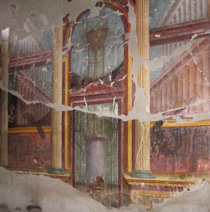 1>
1>In the adjacent room 15, closed door entrances are replaced by a half open gate leading to a sanctuary (fig.1). This is one of the rare instances in Roman wall-painting in which the entrance is depicted open, thus allowing us to see into the virtual space beyond the pictorial wall. The architectonic and natural features in the painting all correspond to human proportion, in so doing they create a seamless transition between the physical space of the room and the virtual space of the painting. This in its turn enhances the embodied relationship between viewer and wall-painting. The metaphysical abode beyond the gate creates a fascinating mise-en-abyme between the concept of the house as sanctuary and its virtual other, as both seamlessly merge together. Although the view through the gate is open it is largely taken up by a pedestal column, on which stands a sacrificial tripod (fig.2). The sanctuary theme is also reinforced by the presence of immortality symbols. These take the form of peacocks perched on ledges either side of the entrance, both of which are accompanied by demonic masks that provide the ubiquitous apotropaic presence thought necessary to ward off malevolent intruders (fig.3). Numerous representations of peacocks have been found on the inner walls of tombs and sarcophagi. It was thought that the eye-like motif on their tails allowed them, and by association, the deceased to see into eternity, thus achieving immortality because eternity equated with immortality.
Beyond the gated facade two tiers of colonnades define the sanctuary boundary. As to the deity that inhabited this sanctified space, we can only surmise that it was Apollo because the tripod on top of the pedestal column and the torch and bull skull (bucrania) at its base are all emblematic of his presence (fig.4). The commemorative ancestor shields (imagines clipeatae) hanging in the upper section of the colonnades, may also suggest that the virtual sanctuary acted as a focus for ancestor cult worship (fig.5). The majority of the wall-paintings depicting entrances were duplicated on opposing walls and therefore this composition is probably mirrored on the opposing wall, but at present this part of the room remains buried beneath a road that skirts the excavation site.
|